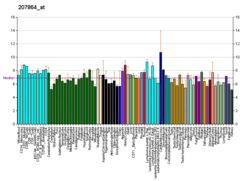SCN7A
Sodium channel protein type 7 subunit alpha is a protein that in humans is encoded by the SCN7A gene on the chromosome specifically located at 2q21-23 chromosome site.[5][6] This is one of 10 Sodium channel types, and is expressed in the heart, the uterus and in glial cells. Its sequence identity is 48, and it is the only sodium channel known to be completely un-blockable by TTX (tetrodotoxin).[7]
See also
Scn7a is the name of the gene that encodes to a membrane protein, in particular a Sodium Channel Nax (also known as NaG, Nav2.1, etc.) It belongs to a family of Sodium Channel known as Voltage-Gated, but is not activated by changes in the membrane's voltage, as happen usually in the members of this family (Nav1.1 to Nav1.9); it activates by changes in the extracellular concentration of sodium [~150 mM].[7]
References
- 1 2 3 GRCh38: Ensembl release 89: ENSG00000136546 - Ensembl, May 2017
- 1 2 3 GRCm38: Ensembl release 89: ENSMUSG00000034810 - Ensembl, May 2017
- ↑ "Human PubMed Reference:".
- ↑ "Mouse PubMed Reference:".
- ↑ Plummer NW, Meisler MH (April 1999). "Evolution and diversity of mammalian sodium channel genes". Genomics. 57 (2): 323–31. doi:10.1006/geno.1998.5735. PMID 10198179.
- ↑ "Entrez Gene: SCN7A sodium channel, voltage-gated, type VII, alpha".
- 1 2 Hiyama TY, Watanabe E, Ono K, Inenaga K, Tamkun MM, Yoshida S, Noda M (June 2002). "Na(x) channel involved in CNS sodium-level sensing". Nature Neuroscience. 5 (6): 511–2. doi:10.1038/nn0602-856. PMID 11992118.
Further reading
- Noda M, Hiyama TY (August 2015). "The Na(x) Channel: What It Is and What It Does". The Neuroscientist. 21 (4): 399–412. doi:10.1177/1073858414541009. PMID 24962095.
- Hiyama TY, Yoshida M, Matsumoto M, Suzuki R, Matsuda T, Watanabe E, Noda M (April 2013). "Endothelin-3 expression in the subfornical organ enhances the sensitivity of Na(x), the brain sodium-level sensor, to suppress salt intake". Cell Metabolism. 17 (4): 507–19. doi:10.1016/j.cmet.2013.02.018. PMID 23541371.
- Shimizu H, Watanabe E, Hiyama TY, Nagakura A, Fujikawa A, Okado H, Yanagawa Y, Obata K, Noda M (April 2007). "Glial Nax channels control lactate signaling to neurons for brain [Na+] sensing". Neuron. 54 (1): 59–72. doi:10.1016/j.neuron.2007.03.014. PMID 17408578.
- Hiyama TY, Watanabe E, Okado H, Noda M (October 2004). "The subfornical organ is the primary locus of sodium-level sensing by Na(x) sodium channels for the control of salt-intake behavior". The Journal of Neuroscience. 24 (42): 9276–81. doi:10.1523/JNEUROSCI.2795-04.2004. PMID 15496663.
- Meyers KJ, Mosley TH, Fox E, Boerwinkle E, Arnett DK, Devereux RB, Kardia SL (May 2007). "Genetic variations associated with echocardiographic left ventricular traits in hypertensive blacks". Hypertension. 49 (5): 992–9. doi:10.1161/HYPERTENSIONAHA.106.081265. PMID 17339538.
- Zhang KX, Zhu DL, He X, Zhang Y, Zhang H, Zhao R, Lin J, Wang GL, Zhang KY, Huang W (December 2003). "[Association of single nucleotide polymorphism in human SCN7A gene with essential hypertension in Chinese]". Zhonghua Yi Xue Yi Chuan Xue Za Zhi = Zhonghua Yixue Yichuanxue Zazhi = Chinese Journal of Medical Genetics. 20 (6): 463–7. PMID 14669210.
- Goldin AL, Barchi RL, Caldwell JH, Hofmann F, Howe JR, Hunter JC, Kallen RG, Mandel G, Meisler MH, Netter YB, Noda M, Tamkun MM, Waxman SG, Wood JN, Catterall WA (November 2000). "Nomenclature of voltage-gated sodium channels". Neuron. 28 (2): 365–8. doi:10.1016/S0896-6273(00)00116-1. PMID 11144347.
- Bonaldo MF, Lennon G, Soares MB (September 1996). "Normalization and subtraction: two approaches to facilitate gene discovery". Genome Research. 6 (9): 791–806. doi:10.1101/gr.6.9.791. PMID 8889548.
- George AL, Knops JF, Han J, Finley WH, Knittle TJ, Tamkun MM, Brown GB (January 1994). "Assignment of a human voltage-dependent sodium channel alpha-subunit gene (SCN6A) to 2q21-q23". Genomics. 19 (2): 395–7. doi:10.1006/geno.1994.1081. PMID 8188276.
- Boyle MB, Heslip LA (1995). "Voltage-dependent Na+ channel mRNA expression in pregnant myometrium". Receptors & Channels. 2 (3): 249–53. PMID 7874451.
- Han JA, Lu CM, Brown GB, Rado TA (January 1991). "Direct amplification of a single dissected chromosomal segment by polymerase chain reaction: a human brain sodium channel gene is on chromosome 2q22-q23". Proceedings of the National Academy of Sciences of the United States of America. 88 (2): 335–9. doi:10.1073/pnas.88.2.335. PMC 50805. PMID 1846440.
- George AL, Knittle TJ, Tamkun MM (June 1992). "Molecular cloning of an atypical voltage-gated sodium channel expressed in human heart and uterus: evidence for a distinct gene family". Proceedings of the National Academy of Sciences of the United States of America. 89 (11): 4893–7. doi:10.1073/pnas.89.11.4893. PMC 49194. PMID 1317577.
External links
- SCN7A+protein,+human at the US National Library of Medicine Medical Subject Headings (MeSH)
This article incorporates text from the United States National Library of Medicine, which is in the public domain.




